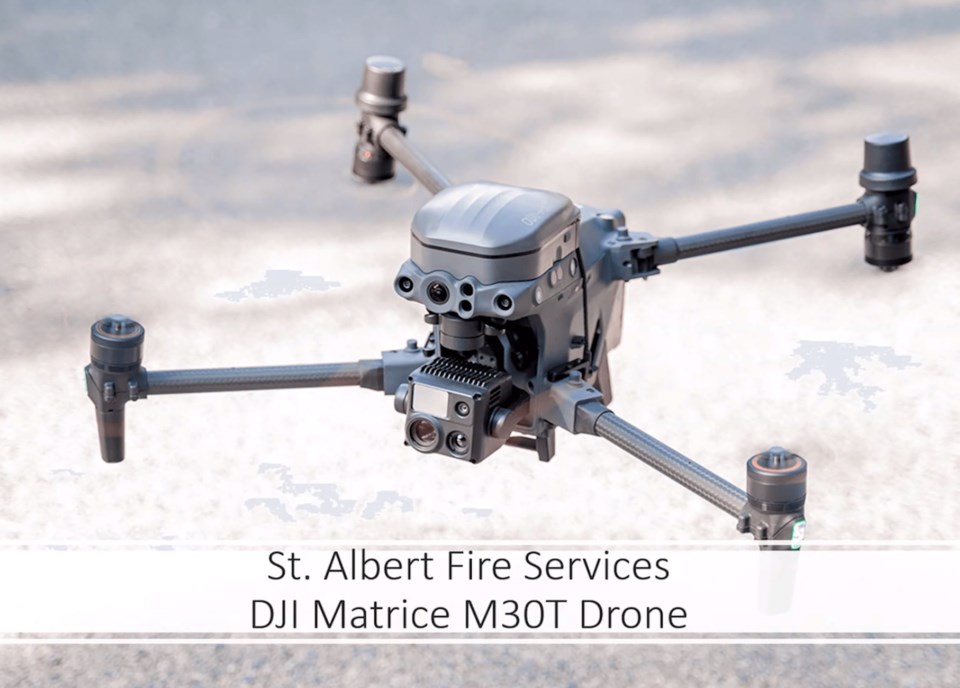A drone has been helping St. Albert firefighters respond to emergencies more efficiently and more precisely, says fire prevention officer Ryan Harley.
“How we use it: the three main things are aerial photography, videography, and for overwatch,” Harley said in a presentation to the citizen-based policing committee last week.
“For us in the fire industry, mostly it's going to be [for] outside fires, structure fires, lost and missing persons, and fire investigations.”
The drone, which city spokesperson Kathy deJong said was purchased early last year, was made by Chinese manufacturer DJI and is a model designed and marketed for use in firefighting, especially given its thermal imaging capabilities.
Harley told the policing committee on May 14 that so far, the drone has been proven to help firefighters save time and energy when it comes to fighting structure fires, and there is serious potential it can help locate lost or missing people quickly.
“A few weeks ago we had a fire in a warehouse, [and] it was behind the walls so we couldn't see where the fire was,” Harley explained. “With the drone we could tell that there was fire on the roof there so we were able to direct the hose stream to that corner so that they can actually fight the fire, rather than just spraying copious amounts of water everywhere.”
“While they were doing that, we flew around the structure as well to just do a quick 360 [degrees] just to ensure that there was no other fire extension on the other side, [and] the fly around took five seconds and it just gave us that capability of knowing that the fire wasn't anywhere else.”
Everett Cooke, the city's fire chief and director of emergency services, told the committee that by using a drone, firefighters can clear entire areas really quickly using thermal imaging when searching for a lost or missing person, saving what could be precious time.
Prior to having the drone, Cooke said, “there was a case not long ago where Fire Services was searching for a lost or missing person just out on [Big] Lake, and the person was actually stuck into the mud.”
“Within minutes he would have been found with this,” Cooke said, with Harley adding that in this case it took firefighters “hours.”
“It was hours and the firefighters were exhausted because they were trudging through the mud as well,” Harley said. “When they got there, they had to take a couple minutes to rest to be able to get him unstuck.”
Harley told the committee not every member of St. Albert Fire Services is qualified to fly the drone, and in fact, he had to attend “helicopter pilot school” in order to be certified to fly it.
“We had to learn the airframe [the mechanical structure of the drone], aeronautical principles, and it was far more advanced than what it takes to fly [regular] drones,” he said. “You have to know it inside out, train on it to know how to use it and deploy it.”
“Especially when something goes wrong, you have to be able to act fast and bring it back into control and also repair it as well.”
The committee also heard the drone's camera has a range of eight kilometres; can withstand up to 100 millimetres of rain in a 24-hour period; can fly in temperatures ranging from -20 C to 50 C; and has an average battery life of about 45 minutes, although the batteries take just 20 minutes to charge.
In all the drone cost $40,000, the committee heard.
St. Albert isn't the first fire department in the region to use drones in, as Morinville Fire Services has been using drones since 2017, while Strathcona County Fire Services started using drones back in 2013.
Beyond municipal fire departments, governments at the provincial and federal level have in recent years been making significant investments in drone technology research to see how drones can be used to respond to wildfires. For example, Sturgeon County's Pegasus Imagery received a $2 million grant from Sustainable Development Technology Canada in 2022 to, among many things, conduct further testing on how their drones manage flying over wildfires to gather and transmit data down to those on the ground at the front line.




